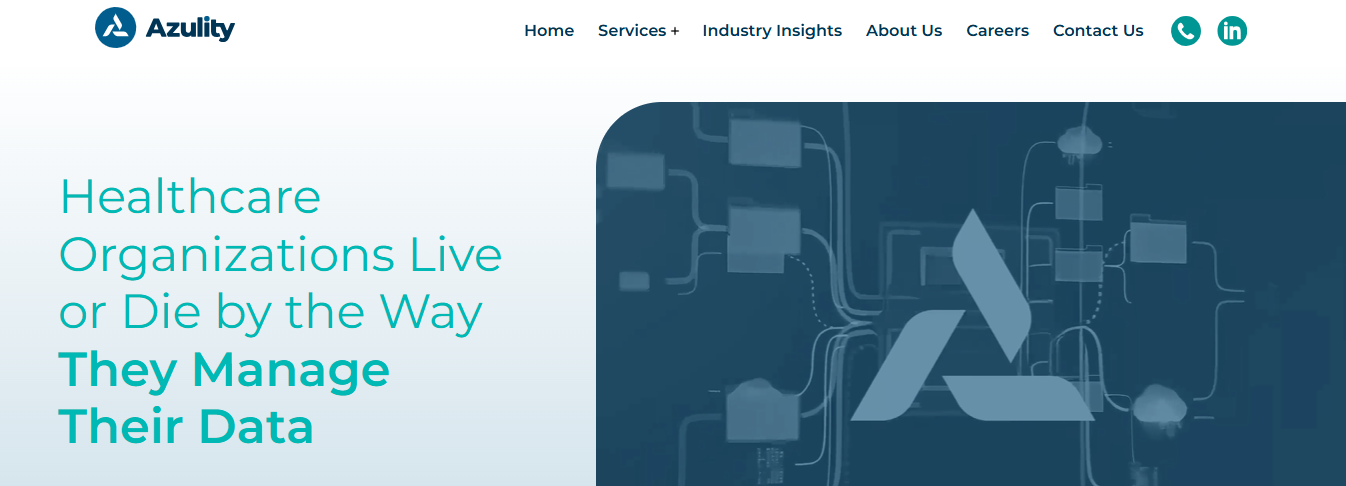Healthcare facilities are struggling, and staffing issues have reached a breaking point. One of the most impacted roles is the healthcare data analyst. The COVID-19 crisis laid bare longstanding staffing issues in healthcare, and the data crunching necessary to respond to the pandemic highlighted the shortage of qualified healthcare data analysts. The problem hasn’t gone away.
As healthcare organizations continue to recover from the pandemic and prepare for future emergencies, they are still grappling with staffing issues. The need for qualified data analysts remains high. This blog will explore healthcare data analyst requirements to help organizations better understand what it takes to recruit for this critical role.
Azulity’s credentialing solution can help organizations allow their staff, especially healthcare data analysts, to get to work with the proper credentials and alleviate the burdens of staffing shortages on operations and patient care.
What is a Healthcare Data Analyst?


In the healthcare ecosystem, healthcare data analysts play a critical role. They gather and organize healthcare data, analyze it to assist in delivering optimal health care management and decision-making, and use this data to achieve administrative needs and goals.
Their responsibilities also include understanding data storage, sharing methods, and investigating data to find patterns and trends. Various organizations employ health care data analysts, including government health care departments, public and private hospitals, insurance companies, diagnostic centers, and consultancy firms.
Related Reading
- Resource Allocation in Healthcare
- Healthcare Workforce Shortage Solutions
- How to Recruit Healthcare Professionals
Healthcare Data Analyst Roles and Responsibilities


Data Collection and Management: The Foundation of Healthcare Analysis
Healthcare data analysts collect and manage data from several health-related areas, including electronic health records, clinical information systems, claims data, patients’ questionnaires, and other relevant databases.
They work to overcome data quality issues, detect problems, and correct errors. They also address missing or incomplete values. Part of their job is ensuring data integrity. They do this by confirming the validity of sources, comparing data against similar sources, and applying data validation measures.
Data Analysis: Spotting Trends and Discovering Insights
Healthcare data analysts use statistical techniques and approaches to analyze data. These include descriptive statistics, regression analysis, predictive models, and machine learning on vast healthcare industry data.
They explore the data trends, using information regarding the patient’s characteristics, the most common diseases, treatment outcomes, readmission frequencies, or expenses. They also utilize system analysis techniques to look for other possibilities that could cause specific issues or outcomes in healthcare.
Reporting and Visualization: Making Data Understandable
Healthcare data analysts offer dependable data processing and issue comprehensive reports, efficient dashboards, and informative visuals to healthcare managers, doctors, etc. They present data in a way that is easy to understand and provides meaningful insights.
Skilled professionals also involve data narratives, visualizations, and other techniques. They adapt the reports and visualizations to the different report users, their requirements, and the setting in which the reports are to be used.
Collaboration: Working with Others for Better Outcomes
Healthcare data analysts engage with doctors, nurses, and other healthcare personnel to identify the requirements and ascertain the relevance and usability of the data analyses produced.
They support IT departments in controlling data, coordinating with them to ensure data systems meet organizational requirements and adhere to data governance policies. Analysts also work in multidisciplinary teams and provide the information needed to make decisions about patients, resources, and organizational outcomes.
Compliance and Security: Maintaining Patient Privacy
Healthcare data analysts are required to preserve the confidentiality and integrity of the data to conform to the standards required by laws. They must adopt proper measures, such as controlling access to patient data and encrypting data, among other measures, that enhance the safety and privacy of the patient data. Besides all these, they are also required to meet legal requirements and adjust legislation and guidelines for handling and protecting healthcare information.
Azulity: The Leader in Healthcare Master Data Management
Azulity specializes in healthcare master data management and provider credentialing services, bringing proven expertise in implementing healthcare data solutions and credentialing across the US. Our comprehensive platform ensures consistent patient, provider, location, and claims data synchronization across all systems and departments.
Key features include: healthcare MDM, provider MDM, reference data management, credentialing, and provider enrollment. We serve healthcare technology leaders – from CIOs and CDOs to VPs of data platforms and credentialing – helping them eliminate the costly problems of fragmented data systems. Book a call to learn more about our healthcare master data management services today!
Healthcare Data Analyst Requirements


Entry Level Skills
Entry-level skills for healthcare data analysts include several competencies that help them succeed immediately. They include:
1. Experience
Most analysts will need at least two years of experience in either healthcare or data analytics before transitioning into a healthcare-focused role.
2. Education
A scientific degree, especially one related to health or data, is desirable for a healthcare data analyst. While a master’s degree will help candidates stand out, a bachelor’s degree is sufficient for most jobs.
3. Data Skills
Healthcare data analysts need advanced proficiency in data wrangling and SQL. This includes talking directly to and manipulating databases through structured query language (SQL). Analysts should be able to write SQL code without relying on an intermediary, guided interface (e.g., a drag-and-drop tool). Many analysts rely on tools like Microsoft Access or Crystal Reports GUI interfaces to generate SQL for their reports.
In doing so, they attain a rudimentary understanding of querying. SQL offers users fine-grained control of the data being pulled. It also provides a powerful way to explore data that is not filtered through a predefined data set or model, as with a business intelligence (BI) tool. Teams that can’t query the data with SQL are beholden to whatever information is pushed to them from another source.
Using a BI tool to generate SQL on your behalf is a good starting point, but there are a couple of potential downsides to using auto-generated queries from BI tools. First, these tools usually underperform because they are poorly constructed (behind the GUI interface). Second, and far more prevalent, is how these tools mistakenly make assumptions about the data and manipulate the data without the user being aware of the underlying logic.
This is dangerous because he may not understand that the query generates duplicate result sets (i.e., tables), excludes some patients that should be included in the result set, or a host of other “I didn’t realize it was doing that” scenarios. If your query feeds a report, and the report provides information people will act upon, you need to be sure you understand the logic embedded in the underlying query.
4. Data Analytics Tools
Healthcare data analysts should have experience with analytics tools like Tableau, Metabase, and Mixpanel.
5. Technical Skills
Basic Python, R, or Ruby proficiency is helpful for healthcare data analysts and enthusiasm for broadening these skills.
6. ETL Processes
The health data analyst needs to be able to perform export, transform, and load (ETL) processes. Simply put, he needs to take data from one system and put it into another. In an EDW, a user pulls data from disparate systems that don’t talk to one another.
For example, you may have an EMR system, a patient satisfaction system, and a costing system that don’t interface directly. Making a copy of the data found in each of these systems and pulling the data into the warehouse will allow data integration from the various systems. This movement of data is accomplished through the ETL process.
7. Microsoft Office
Healthcare data analysts need to be competent in the Microsoft Office suite of applications (especially Excel) and have knowledge of database and reporting software.
Data Modeling
Data modeling is a fancy way for an analyst to write code that models real-world processes and workflows. Let’s consider a common healthcare scenario: a hospital admission. What information do I need to capture to model that workflow? In this example, you’d need some demographic information, such as the patient’s name, date of birth, gender, and complete address. You’d likely want to pull insurance information, such as the plan name, copay amount, and effective coverage date.
Clinically, you would like to know some history. Is this patient new to the system? Do we already have a medical record number for the patient (indicating we have seen her before)? What is the admitting diagnosis? Who is the attending provider for the admission? Did the patient come through the emergency department or some other venue? A good data model captures all of these elements and relates them meaningfully to reflect the workflow.
Data Analysis
An analytics team member needs to be able to make sense of the data once it is in the EDW. So much information is produced in healthcare; not all of it is relevant to an analysis that can drive improvements. A good analyst can sift through data to extract pertinent insights.
This requires some complex thinking around set theory and the ability to do his analysis through SQL, a statistical reporting tool, or a combination thereof. In healthcare, a lot of attention is paid to managing diabetic patients.
Diabetes is a chronic condition that affects the patient’s quality of life, and if not well managed, can be lethal. From a financial perspective, diabetes is highly costly if mismanaged. An analyst may be part of a clinical improvement team tasked with managing diabetes within the health system. But if diabetes is a clinical condition, what possible value could an analyst bring to the team?
Consider this
A health system may manage a large population of diabetics that may be stratified into low, medium, and high-risk stratifications. Clinical markers called out by physicians determine the classification of patients into one of these three categories.
But what if the health system wanted to know more, such as its total number of diabetic patients? How many of these patients are in each category of risk? What is the movement of low to medium risk on a year-over-year trend? How about the trend of movement from medium to high risk?
An analyst will be tasked with mining the available data to answer these questions and will add tremendous value if he can highlight potential reasons that explain the “why.” Why the movement from low to medium? What statistical correlations can be drawn and then effectively tested? A health data analyst fills that role for the team.
Business Intelligence BI Reporting
An analytics team member needs to be able to present data in a way that’s intuitive to nontechnical users. The visual representation must be simple to interpret by a lay audience. While this sounds simple, this skill is difficult to execute well. It separates an average analyst from a stellar one. In a real sense, this is akin to being an interpreter. An interpreter hears words spoken in one language and then speaks a different language to the target audience.
Without a strong mastery of both languages, translation is difficult, if not impossible. Apart from the mechanics of words, language rules, and semantics, embedded nuances, such as metaphors or idioms, further enrich the communication experience. An excellent interpreter can convey meaning, not just words, ideally. Likewise, the data expert needs to translate database speak, that is, mining data to find meaning, into simple graphics that perfectly convey the meaning, all while avoiding potentially ambiguous conclusions.
Telling The Story of The Visualizations
The analytics team member must communicate effectively the stories embedded in the data.
Think of it this way
BI reporting contextualizes meaning in bits, pieces, or a micro view. Telling the story means providing a logical flow to connect many meanings to create a big picture view. Let me further illustrate with an example. Research indicates that one of the clinical best practices for diabetic patients is to perform a hemoglobin A1C (A1C) test on a patient’s blood every year. Other best practices include getting a yearly eye exam, foot exam, and blood pressure evaluation.
A data expert tasked with reporting on A1C testing, eye exams, foot exams, and blood pressures gives meaning to the data elements capturing these measures. The analyst searches databases to find all the possible ways A1C results are represented in the EDW. The same exercise is done to find eye exam, foot exam, and blood pressure data. The skill of BI reporting helps clinicians and care managers identify patients who have care gaps (e.g., patients missing eye exams, foot exams, A1C testing).
These are meaningful measures, but are just part of a bigger picture. Telling the story in this example means helping the organization see how well it manages its diabetic population through evidence-based medicine. Telling the tale considers all measures (e.g., A1C testing, blood pressure testing, eye exams) across the managed population. It finds where the system is doing well, or where there is variation in care delivery. Telling the story also means looking at clinical and financial outcomes.
Just because a system is good at delivering care, it doesn’t necessarily mean all outcomes are optimal. At what cost is the care being delivered? Perhaps the clinical outcomes scores are noteworthy but not financially sustainable. Telling the story means calling this out and using data to suggest ways to reduce cost without sacrificing quality. In summary, an analytics team member adept at telling the whole story (technical detail and big picture thinking) understands the business she supports. This is an extremely valuable skill.
Related Reading
How to Become a Healthcare Data Analyst in 5 Simple Steps


Unlocking Opportunities with Azulity
Azulity focuses on data management in healthcare. The company specializes in master data management and provider credentialing services. It has deep experience implementing data solutions that improve efficiency and care quality across the US. Its platform allows for consistent patient, provider, location, and claims data synchronization across departments and systems.
Key features of Azulity’s services include healthcare master data management, provider reference data management, credentialing, and provider enrollment. They help healthcare technology leaders eliminate the costly problems of fragmented data systems. Book a call today to learn more about how Azulity can help you.
Get a Formal Education
A bachelor’s degree is essential to becoming a healthcare data analyst. Aim for a degree in a science or math-related field. This will help you learn medical terminology and the ethical standards for processing patient information. These programs can expose you to technology used in the industry. Healthcare data analysts typically study health information management, health informatics, data science, information technology, computer science, statistics, and economics.
Consider a Master’s Degree
While a master’s degree isn’t required, it can help you stand out to employers. For example, earning a Master of Business Administration can help you learn leadership and organizational management skills. You can also study health informatics at an advanced level and gain specialized knowledge about the healthcare field that you can apply to your role as a healthcare data analyst.
Gain Experience in Healthcare
Working in healthcare for one to two years can help you transition to a healthcare data analyst role. Consider completing a clinical internship or applying for entry-level positions as a medical office administrator. These experiences will allow you to observe how facilities run and gain exposure to working with patients and organizing medical records.
Get Certified
You need the American Health Information Management Association (AHIMA) certification to become a certified healthcare data analyst. This requires passing a written certification exam and one of the following credentials: A bachelor’s degree and three years of professional experience, A master’s degree and one year of experience working with healthcare data, A registered health information technician credential (RHIT) and at least three years of experience working with healthcare data, or A registered health information administrator credential (RHIA).
Book a Call to Learn More About Our Provider Credentialing Services


Azulity specializes in healthcare master data management and provider credentialing services, bringing proven expertise in implementing healthcare data solutions and credentialing across the US. Our comprehensive platform ensures consistent patient, provider, location, and claims data synchronization across all systems and departments.
Key features include: healthcare MDM, provider MDM, reference data management, credentialing, and provider enrollment. We serve healthcare technology leaders – from CIOs and CDOs to VPs of data platforms and credentialing – helping them eliminate the costly problems of fragmented data systems. Book a call to learn more about our healthcare master data management services today!
